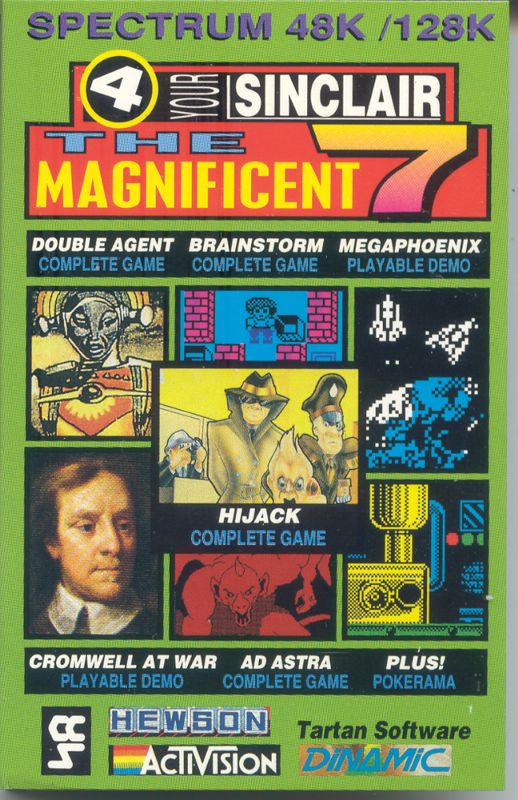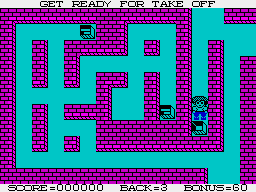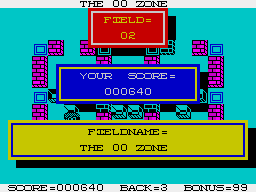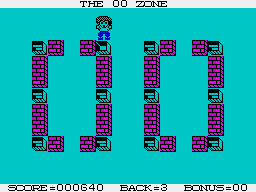Retro Replay Review
Gameplay
The Your Sinclair Magnificent 7 July 1991 compilation offers a varied buffet of play styles, starting with Brainsport, a Sokoban-inspired puzzle title. Here, you guide a lone avatar through a network of narrow corridors, pushing bricks one at a time into designated goal areas. The challenge lies in planning ahead: push a brick the wrong way and you might find yourself irretrievably stuck, forcing a reset or the use of a level password. Points only register upon full completion, rewarding both difficulty and speed, which adds a strong incentive for replaying the tougher mazes to shave off seconds.
(HEY YOU!! We hope you enjoy! We try not to run ads. So basically, this is a very expensive hobby running this site. Please consider joining us for updates, forums, and more. Network w/ us to make some cash or friends while retro gaming, and you can win some free retro games for posting. Okay, carry on 👍)
Double Agent switches gears completely, presenting an interactive fiction scenario with two characters on the hostile world of Marego. You alternate control between the pair as you direct each shell-like survivor to gather energy-giving substances. Movement automatically triggers a character swap, but you can also force the change manually—this mechanic enriches the puzzle of not only conquering the alien environment but also mastering your own split-focus strategy. Typing commands feels responsive, and the branching narrative keeps you on the edge of your seat.
Hijack and Ad Astra bring action and adventure to the tape. Hijack casts you as a counter-terrorist operative navigating enemy-infested buildings, searching for hostages and disarming bombs. Its isometric viewpoint and friction-based movement introduce a tactile feel to every corridor sweep. Ad Astra, though an early foray into Spectrum 3D shooters, impresses with rudimentary vector graphics and fast-paced flight sequences—while it may not compare to later titles, it’s a notable technical achievement for the platform.
Completing the package are demo versions of Megaphoenix, a retro-style vertical shooter, and Cromwell at War, a turn-based strategy snippet that hints at depth without fully delivering its promise. These trial slices give a taste but leave you craving the full products. Finally, the inclusion of several POKE cheats rounds off the tape, offering instant lives, infinite ammo, or level skips for compatible titles—perfect for players who want to breeze past the hardest parts or experiment with game mechanics.
Between logic puzzles, text adventures, action shooters, and strategic teases, the gameplay variety on this cassette is one of its strongest selling points. Each title presents a distinct challenge, ensuring that boredom never sets in and that you always have something new to tackle.
Graphics
Graphically, the compilation leans into the ZX Spectrum’s strengths, delivering clean, contrasting visuals across all titles. Brainsport’s mazes are rendered with crisply defined walls and blocks, relying on simple tile graphics that ensure perfect readability even when the corridors narrow to a single pixel-wide gap. Animation is minimal but functional—every brick slide and character step is clear, preventing any confusion in intricate levels.
Double Agent’s text-heavy interface is naturally sparse on sprites, but the occasional location illustrations add atmosphere. These black-and-white line drawings help set mood without overtaxing the Spectrum’s limited color palette. Without the need for scrolling or sprite flicker, the text parser runs smoothly and keeps your focus on puzzle-solving and narrative choices.
Hijack benefits from an isometric engine that handles pseudo-3D perspective surprisingly well. Walls and furniture cast simple shadows, and enemies are represented by small but recognizable sprites. Ad Astra’s vector-style graphics push the Spectrum into a quasi-3D realm, with wireframe ships and obstacles zipping by. While not as colorful as later titles, the smooth frame rate and clear object outlines make for an engaging shooter experience.
The demo games Megaphoenix and Cromwell at War show promise but feel a touch rough around the edges. Megaphoenix features crisp vertical-scrolling backdrops and fast-moving enemy sprites, though color clash occasionally flickers in heavy action. Cromwell at War’s map screens are functional, with hex-based tiles that color-code terrain types, but unit sprites are little more than colored dots. These demos suggest a fuller release could polish their visuals further.
Story
Storytelling takes center stage in Double Agent, where the dual-character premise creates an engaging narrative hook. You learn fragments of backstory—why these agents survived, what went wrong in the initial assault, and the stakes for their mission. The plot unfolds through your typed commands, and each successful retrieval of energy substances gradually reveals more about the planet’s dangers and the agents’ past lives. Though minimalist, the story effectively drives exploration.
Hijack weaves its own action-thriller narrative, casting you as a valiant hero against a looming terrorist plot. Brief text prompts set objectives between each screen: “Find the code to disarm the bomb!” or “Rescue the hostage before time runs out!” These mission briefs are sparse but punchy, creating a sense of urgency that pairs well with the ticking in-game countdowns.
Ad Astra’s storyline is mostly implied—there’s an interstellar mission to repel invaders or retrieve vital data—but it leans heavily on sense of spectacle over detailed plot. The wireframe landscapes evoke the feeling of deep-space combat, and scattered textual introductions to each level hint at a larger conflict beyond the cockpit. It’s lean in narrative ambition but succeeds in sparking the imagination.
Brainsport and the demo games don’t offer much in the way of story, focusing instead on pure mechanics. Still, the lack of narrative doesn’t feel like a detractor; Brainsport’s escalating puzzle design creates its own sense of progression. Megaphoenix and Cromwell at War demo slices sketch brief scenarios—one of intergalactic warfare, the other of 17th-century campaigns—but invite players to seek the full narrative in the retail versions.
Overall Experience
As a cover-mounted compilation, Your Sinclair Magnificent 7 July 1991 delivers exceptional value for Spectrum enthusiasts. You get two exclusive titles (Brainsport and Double Agent) that rival commercial releases in polish, alongside two full games (Hijack and Ad Astra) and two enticing demos. Whether you’re a puzzle fan, an action junkie, or a strategy buff, there’s something to keep you engaged for hours.
Load times are typical for tape-based Spectrum games—each title takes around 30 to 60 seconds to load—but the variety of content makes frequent reloads feel less tedious. Password systems in Brainsport and intermittent saves in Double Agent mean you can pick up where you left off without replaying earlier stages, a thoughtful inclusion for a budget tape.
The inclusion of POKE cheats is a welcome bonus for novice players who may struggle with the more fiendish puzzles or hostile shooters. Infinite lives in Hijack or instant level completion in Brainsport can remove frustration and let you experience the game flow uninterrupted. For collectors and retro gamers, these cheats double as a nostalgia trip back to the Spectrum 48K homebrew scene.
In summary, this compilation stands out as a well-rounded package that underscores the creativity of early ’90s Spectrum development. It may not boast the graphical flash of later 16-bit titles, but its gameplay diversity, solid storytelling in key entries, and overall polish make it a compelling purchase for anyone looking to explore or revisit the golden age of home computing games.
 Retro Replay Retro Replay gaming reviews, news, emulation, geek stuff and more!
Retro Replay Retro Replay gaming reviews, news, emulation, geek stuff and more!









Reviews
There are no reviews yet.